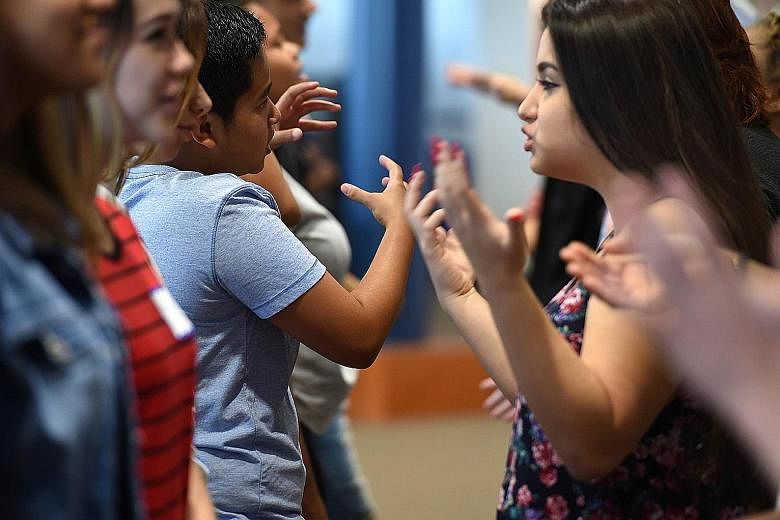Finland's schools were once the envy of the world. Now, they're slipping. What has happened?
That's a question educators around the globe are asking in the wake of the latest results of an ongoing study that measures academic achievement in 73 countries.
For much of the 21st century, Finland has been one of the very top performers in the Programme for International Student Assessment (Pisa). Administered every three years, it tests the reading, mathematics and science literacy of 15-year-olds.
Pisa does not measure memorisable facts, but rather how students apply theory and thinking in answering questions. Finland's students had been so successful in these tests that educators and leaders of other countries began looking to the country as an example of how to run an effective education system.
Headlines show a world smitten with the Finnish approach: "How Finland broke every rule - and created a top school system"; "What Finland can teach China about education"; "What if Finland's great teachers taught in US schools"; and "Happy teaching, Happy learning: 13 secrets to Finland's success".
But in the 2015 Pisa iteration, the results of which were released last week and which Singapore topped, Finland continued a slide first evidenced in the 2012 results, when the country's maths score dropped out of the top 10 for the first time. The drop-off in maths scores from 2009 to 2012 was 2.8 per cent. Science scores dropped 3 per cent, and reading 1.7 per cent.
In the 2015 results, Finland's scores dropped in all three categories: 11 points in science, five points in reading and 10 points in maths.
Finland is now ranked 12th in maths, fifth in science and fourth in reading. Its high-achieving students were seen as an example to be emulated. Now, there are questions about what is causing the drop-off and how it should be addressed.
Some of those questions were put to Dr Pasi Sahlberg, a Finnish educator and leading figure in education policy and the author of the best- selling book, Finnish Lessons 2.0 What Can The World Learn From Educational Change In Finland.
Q What do you think best explains Finland's drop in the Pisa results? Is it that more countries have simply caught up to what Finland was doing, or is there a fundamental change that has taken place in Finland as to how and what children there are learning?
A It has been difficult to explain why some countries, including Finland, have been performing well in international school system comparisons. It is equally difficult to explain precisely why countries are slipping down in these same charts.
One important dimension is the equity of education, that is, how fair is the school system for children from different backgrounds?
Even in this broader perspective, there has been a notable decline in Finland's performance, both in terms of students' learning outcomes and equity of the education system (as we know now, these two dimensions often go hand in hand). I have suggested three main reasons for this decline that already started some eight or so years ago.
First, there has been a visible and alarming downward trend in Finnish schoolboys' educational performance during the past decade. This inconvenient phenomenon is stronger in Finland than in any other OECD (Organisation for Economic Cooperation and Development) country.
As a result, Finland is the only country where girls significantly outperform boys not only in reading but also in maths and science. One factor that explains this is related to the diminished role of reading for pleasure among boys.
Finland used to have the best primary school readers in the world until the early 2000s, but not any more. Pisa test items rely heavily on the test-taker's reading comprehension. Appearance of handheld technologies like smartphones among school-aged children in this decade has probably accelerated this trend.
Second, rapidly increased "screen time" with media is often eating into the time spent with books and reading in general. According to some national statistics, most teenagers in Finland spend more than four hours a day on the Internet (not including time with TV) and the number of heavy Internet and other media users (more than eight hours a day) is increasing just as it is doing in the United States, Canada and beyond.
Emerging research on how the Internet affects the brain - and thereby learning - suggests three principal consequences: shallower information processing, increased distractibility and altered self-control mechanisms. If this is true, there is reason to believe increasing use of digital technologies for communication, interaction and entertainment will make concentration on complex conceptual issues, like those in maths and science, more difficult. Interestingly, most countries are witnessing this same phenomenon of digital distraction among youth.
Third, Finland has had a very serious economic downturn since 2008 that affected education more than other public sectors. Sustained austerity forced most of its 300-plus municipalities to cut spending, merge schools, increase class sizes and limit access to professional development and school improvement.
The most harmful consequence is the declining number of support staff, classroom assistants and special education personnel. Finland's strength earlier was its relatively small number of low-performing students. Now, the number of those students with inadequate performance in reading, maths and science is approaching international averages. In Finland, this is probably the most significant driver of increasing inequality within education.
I think that the fact that most OECD countries have shaped their national education policies - that is, curriculum, instruction time and testing - to be aligned with Pisa, hoping that this would increase their Pisa scores, has affected Finland's position internationally. Education policies in Finland are not targeted to do well in Pisa at all.
Q Can you foresee any changes that Finland would consider to address this fall-off?
A Pisa is not seen in Finland as a trigger for education reforms. There will be no new policy changes that would be inspired by Pisa in Finland. The Ministry of Education has launched a national programme that aims at improving primary and lower secondary education.
This includes more student-centred pedagogies, strengthened student engagement in school, more physical activity for all students and more technology in classrooms.
The Finnish way of thinking is that the best way to address insufficient educational performance is not to raise standards or increase instruction time (or homework) but make school a more interesting and enjoyable place for all. Raising student motivation and well-being in school in general are among the main goals of current education policy in Finland.
Q Many countries tried to learn from what Finland has accomplished in education. Should these new results give other countries pause?
A What we need to underline here is that Pisa tells us only a small part of what happens in education in any country. Most of what Finland does, for example, is not shown in Pisa at all. It would be shortsighted to conclude by only looking at Pisa scores where good educational ideas and inspiration might be found.
The country's early-childhood education, highly regarded teaching profession, strong focus on well-being and whole child development, and alternative models of accountability still continue to be useful areas of interest for others.
I would argue that it is now very interesting for others to take a closer look at how Finland will deal with this new situation of slipping international results.
The first lesson certainly is that the best way to react is not to adjust schooling to aim at higher Pisa scores. In the coming years, foreign observers will see more integrated interdisciplinary teaching and learning in Finnish schools that actually will decrease instruction time in maths and science. They will also witness more emphasis on arts and physical activity in all schools.
The second lesson is that sustainable improvement of education requires protecting and enhancement of equity and equality in education. International visitors are likely to see intensified conversation in Finland across political parties and opinions on making the education system better serve everyone.
Finally, what Finland should learn from these recent results is that reducing education spending always comes with consequences. It is very shortsighted to think that high educational performance and continuing betterment of schools would be possible when resources are shrinking. Whether Finland's politicians and bureaucrats take these lessons seriously remains to be seen.
WASHINGTON POST


